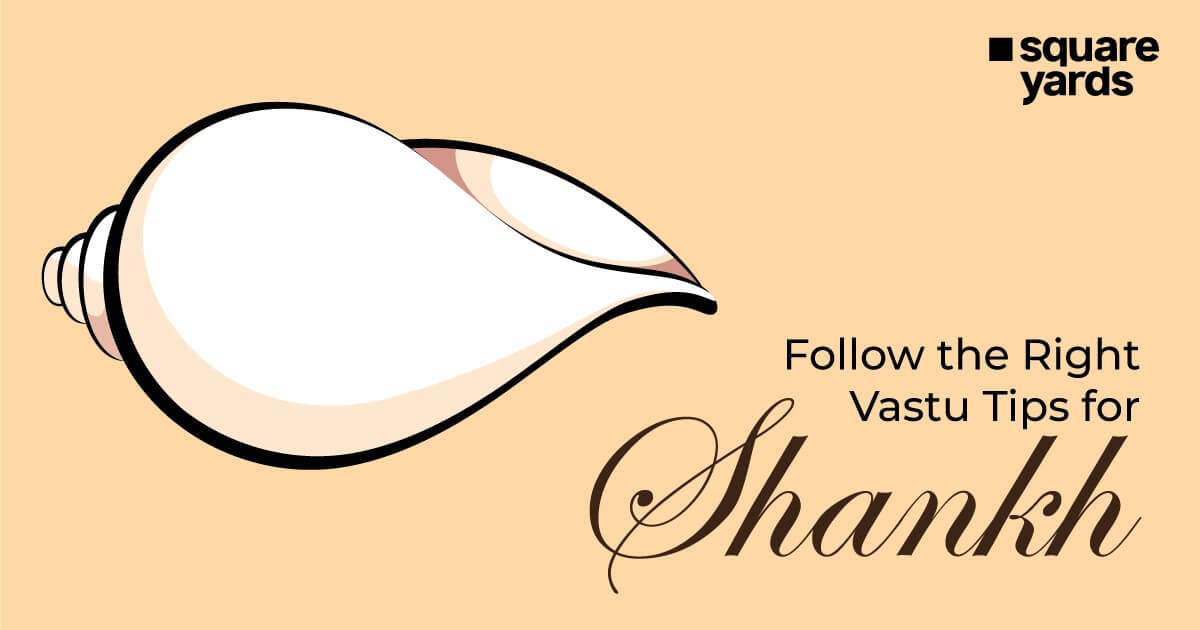As per Vedic astrology, if you place a Shankh in your house, it will remove all your Vastu doshas. It is said that different types of Shankhs have different purposes Some bring wealth, abundance, happiness, or peace to the house. But you have to practice Shankh Vastu tips in order to use them to invite good luck.
Shankhs are considered deities, therefore, you have to follow all the rules for placing them at your worship site. They are used for filling water and can also be blown as a flute. In Hinduism, it is considered one of the greatest of the five worshipping elements. It represents air and a gust of life.
The word Shankh in Sanskrit is made with a combination of two words - Shum meaning great, and Kham, meaning water. Therefore, it means that it is used for holding sacred water.
In this blog, you will learn about the types, uses, and Shankh Vastu Tips.
Table of contents
Types of Shankh as per Vastu
There are different types of Shankh, each named after different Gods. For instance, the right-handed Shankh is for Lord Vishnu, and the left-hand one belongs to Lord Shiva. Here are a few more types of Shankhs.
- Ganesha Shankha
- Gaumukhi Shankha
- Vamavarti Shankh
- Dakshnivarta Shankh
- Gomati chakra
- Heera Shankh
- Kauri Shankh
- Moti Shankh
1. Ganesha Shankha
Ganesha Shankh is best kept at the home temple. You can worship it every day or only during religious holidays, at your convenience. However, if you do not wish to use it every day for worship, it is better to store it in a locker and cover it with a red cloth.
Ganesha Shankh represents Lord Ganesha and is worshipped to eliminate the barriers to success, wisdom, good fortune, and prosperity.
2. Moti Shankh
Moti Shankh is as lustrous as a pearl and is rare to find. The moti Shankh is highly valuable and comes in all sizes. Placing this Shankh in your home can attract good fortune, success, wealth, and peace.
3. Heera Shankh
Heera Shankh is also popularly known as Pahadi Shankh. It is used in worshipping Lord Vishnu and Goddess Lakshmi. Heera Shankh is a right-sided conch shell and comes in a variety of colours. The Heera Shankh bestows enormous prosperity, fortune, and protection.
4. Kauri Shankh
Kauri is Mahalakshmi's beloved creation, according to Hindu shastras. It is said to bring prosperity and wealth. It’s an ancient saying that Kauris always bring wealth and prosperity. According to Hindu mythology, the kauri was acquired during the Samudra Manthan along with Lakshmiji, Apsaras (nymphs), Kamadhenu (wish-granting cow), Uchhaishravas (Seven-headed horse), Kaustubh (divine jewel), and other sacred objects. It is considered so auspicious that it was used as cash in ancient times, in the bride's dress, and by Lord Shiva to adorn Nandi.
5. Gaumukhi Shankha
Gaumukhi Shankh, also known as Panchmukhi Shankh and cow conch,. Placing Gaumukhi Shankh at a temple in the home offers similar blessings and benefits you will receive by keeping an actual cow at your place. In Hinduism, a cow is a holy animal and symbolises surplus. Preserving this Gaumukhi Shankh in your home will definitely bring you joy and good fortune.
Make Your home Vastu Compliant - with Top Vastu Consultant
6. Vamavarti Shankh
Vamavarti Shankh opens towards the left hand with its mouth in the centre. This is the most prevalent Shankh used for all religious occasions. The blowing of a Vamavarti Shankh cleanses the environment and eliminates bad energy. It is said to be Goddess Lakshmi's brother and Lord Vishnu's favourite.
How to keep Vamavarti Shankh in Pooja Room
- In the Pooja Room, keeping a Vamavarti Shankh entails adhering to specific Hindu customs and procedures.
- Getting a real, clean Vamavarti Shankh (a sacred conch shell with a leftward spiral) is the first and most important step.
- Wash the Shankh with clean water to purify it before putting it in the Pooja Room. After that, conduct a customary Pooja, or prayer ritual, to call forth the blessings of the gods.
- The Vamavarti Shankh should be positioned in the Pooja Room on a clean cloth or pedestal, ideally facing east or northeast, as these are lucky directions.
7. Dakshnivarta Shankh (How to Keep Dakshinavarti Shankh at Home)
The Lakshmi Shankh is also known by another name - Dakshinavarti Shankh. Daksinavarta or Dakshinavarti Shankh, is open on the right side and is said to be the residence of Kuber, the deity of riches. Because it has a closed mouth, it can only be worshipped and cannot be blown. Conch shells with the right hand are considered lucky, attracting good fortune, serenity, and prosperity. You can use right-handed conch shells in the puja room in the north, east, or northeast direction. This Shankh should be adorned with a swastika and worshipped using diyas, sandalwood, and flowers.
8. Gomati Chakra
The Gomati Chakra looks like a gem of shell stone, resembling Lord Krishna's Sudarshan Chakra. It is used in puja or religious rituals. As per experts’ suggested Shankh vastu tips
, if you bury Gomati Chakra at the foundation of structures, all your Vastu doshas will be removed, and it will confer wealth and longevity to the residents. On Diwali, this admired emblem is worshipped with Goddess Lakshmi in different regions of India. Gomati Chakra activates wealth when covered in a piece of cloth and stored within a money box.
Must Read: 31 Creative and Beautiful Ganpati Decoration Ideas for Ganesh Chaturthi 2025
How to Keep Shankh in Pooja Room
Keeping a Shankh (conch shell) in the pooja room is a traditional practice in Hindu households believed to bring auspiciousness and positive energy. It is said that the position of shankh in pooja room, it is advisable to position it in the northeast or east direction, as per Vastu Shastra.
- Before placing the Shankh, it should be cleaned with water and then purified with Ganga jal (holy water from the Ganges river) or sacred water from a nearby temple.
- It is essential to ensure that the Shankh is placed on a clean and elevated platform, such as a plate or a stand, to prevent it from touching the ground.
- The pointed end of the Shankh should face towards the interior of the pooja room, symbolizing the direction of positive energy flow.
- Regularly cleansing the Shankh and the surrounding area with water and chanting of sacred mantras enhances its spiritual significance and maintains its sanctity.
- Additionally, the presence of a Shankh is believed to emit positive vibrations, contributing to a serene and harmonious atmosphere in the pooja room.
Benefits of Keeping Shankh at Home
As per religious beliefs and Shankh Vastu Tips, the conch shell must be placed in the temple in your home on a very auspicious day.
- When maintained properly at home, Shankh brings prosperity and success.
- Negative energies are repelled by Shankh, whereas optimism and harmony are welcomed.
- Make sure to spray water using a conch shell all over the home to push away bad energy.
- Shankh, which invokes Saraswati, provides wisdom.
- Blowing the Shankh every day helps in eliminating all the Vastu doshas in a home.
- To deepen the relationship between a couple, keep conches in the bedroom.
Dos and Don'ts with Shankh
Shankhs are considered a very pure symbol equal to deities. Therefore, one must know the right and wrong of placing them in your home temple or while using them during any prosperous occasion. Here are some dos and don’ts one must follow:
- Do not use Shankh for offering water to any of the Gods if you have already blown it during prayers.
- According to Vastus tips for Shankh, use only holy water to clean it.
- You have to clean the Shankh daily and cover it with a white or red cloth.
- While placing the Shankhvastu tips in your puja room, you have to fill the Shankh with holy water.
- You have to blow your worshipping Shankh two times a day.
- Do not use the Shankh to offer water to Lord Shiva.
- Never place two Shankhs together for worshiping.
- Ensure to never place the Shankh on the ground as it is considered a deity.
- Never keep a chipped, broken, or cracked Shankh at home even as a showpiece.
- Never use thorny or coral Shankh as a decor item in your house as they can disturb the positive energy of the home.
Conclusion
Shankh Vastu Tips are helpful only if you understand the value of each Shankh and how to keep it in your house. Well, we hope now you know all the dos and don’ts about every type of Shankh. Placing these valuable and auspicious shankhs at home can turn your life at home in a positive manner.
Frequently Asked Questions (FAQs)
Which direction should we keep Shankh?
Make sure that you place your Shankh in a clockwise direction. It is the best Vastu tip for Shankh, as per the Vastu Shastra of Navratri.
Where to Keep Shankh at Home?
The right-handed or Dakshinavarti conch shells must be placed in the puja room. The puja room must be in the north, east or in the northeast direction. Also, as per experts’ suggestions about Shankh Vastu Tips, blowing a Shankh also purifies the lungs and the impurities within. The shells also cure ailments from the water.
How do you know if your Shankh is right-handed?
Scientifically, a Shankhani shell has an opening on the right when seen with the spire upward.
How to place Lakshmi Vishnu Shankh?
You must place your Lakshmi Vishnu Shankh in the right hand. The right-hand side brings peace, good luck, and positive vibes.
Keeping shankh at home is good or bad ?
You can place Shankh or conch shells in your house to get rid of Vastu dosha as it brings good luck and prosperity. It is auspicious and its sound invites peace, positive vibes, and good charm to your home.
How do you clean Shankh at home?
To clean your Shankh at home, you have to take equal parts bleach and water in a bowl and soak the conch shell for about 24 hours. Now, slightly scrub your shells with a brush to remove all the dirt and grime from the inner corners. Moreover, if they have any barnacles on them you must use a screwdriver, a sharp dental tool, or a strong pick to gently wash them away.





